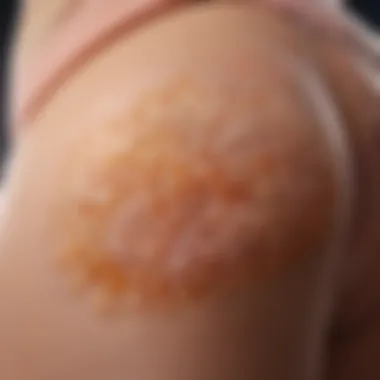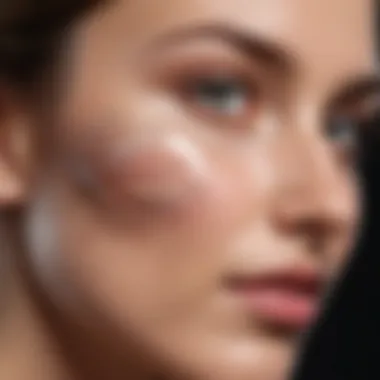Exploring Retinol's Impact on Cellulite Reduction


Intro
Cellulite is a condition that many women face at some point in their lives. It manifests as a dimpled texture on the skin, often appearing on the thighs, hips, and buttocks. While cellulite does not pose any health risks, it can affect self-esteem and body image. Due to its pervasive nature, there is an ongoing search for effective treatments. One such ingredient gaining popularity in discussions about cellulite reduction is retinol, a derivative of vitamin A. This article delves into the efficacy of retinol in treating cellulite, exploring its biological effects, application methods, and its standing among alternative treatments.
Key Trends
As the beauty industry evolves, new trends emerge that shape skincare routines and product formulations. The recent trend towards ingredient-focused treatments highlights the significance of active components like retinol. As more women become informed about skincare, they seek products that offer scientific backing.
Overview of Current Fashion Trends
Today, consumers are leaning towards solutions that blend beauty with health. A growing emphasis on skin health drives the conversation around ingredients. With retinol being known primarily for its anti-aging properties, it is now being reevaluated in the context of cellulite, showcasing potential dermatological advancements.
Popular Beauty Trends
In the realm of beauty, the focus on natural ingredients continues to gain traction. While synthetic materials do have roles in formulations, consumers increasingly prefer transparently sourced ingredients like retinol. This trend informs how products are marketed, encouraging more brands to incorporate retinol into their cellulite-related offerings.
Understanding Retinol's Mechanism
Retinol works by enhancing skin cell turnover, promoting the shedding of older cells while encouraging the production of new ones. This process can improve skin texture and tone, which is where its potential benefits in treating cellulite come into play. By aiding in the thickening of the skin's epidermal layer, retinol may help reduce the visibility of the underlying fat structures that create the dimpled appearance of cellulite.
Potential Side Effects
Despite its benefits, retinol is not without side effects. Common issues may include redness, irritation, and peeling of the skin. These reactions are typical, particularly for individuals new to retinol products. It is critical to introduce retinol gradually into one's skincare routine, allowing the skin to adjust to this potent ingredient.
"Understanding how to use retinol effectively is crucial for mitigating side effects but also for maximizing its benefits against cellulite."
Application Methods
To effectively harness retinol's potential, proper application is essential. It is recommended to start with a lower concentration and gradually increase as your skin adjusts. Always apply retinol products in the evening, as sunlight can reduce their effectiveness. After cleansing, a small amount should be distributed evenly over the affected areas, followed by a moisturizer to combat any dryness. It is also advisable to use sunscreen during the day due to increased photosensitivity.
Alternative Treatments for Cellulite
While retinol is promising, it is not the sole option for managing cellulite. Other treatments include caffeine-infused creams, laser therapy, and radiofrequency treatments. Each approach has its own advantages and disadvantages, making it essential for individuals to research and possibly consult a dermatologist before choosing a method.
Finale
Retinol presents a compelling case as an ingredient for reducing cellulite. While it may not be a miracle solution, its ability to improve skin texture can certainly contribute to a more refined appearance. As women's interest in effective skincare continues to grow, understanding retinol's function and potential must be prioritized. Furthermore, considering alternatives and consulting with professionals will ensure a more tailored approach to managing cellulite.
Foreword to Cellulite
Cellulite is a prevalent aesthetic concern, particularly among women. It manifests as dimpled skin, often found on the thighs, buttocks, and abdomen. This condition can impact one's self-esteem and body image, prompting a quest for effective solutions. Understanding cellulite is essential for addressing this issue, as knowledge empowers individuals to make informed decisions.
Cellulite affects a wide demographic, from teenagers to older women. Many often perceive it as an unwelcome mark of beauty; thus, exploring the underlying mechanisms is crucial. This section aims to clarify what cellulite is and how it forms, laying the groundwork for further discussion on treatments like retinol.
Understanding Cellulite
Cellulite primarily arises when fat deposits push through the connective tissue beneath the skin. The skin structure plays a significant role in this, as the connective fibers are typically more elastic in some people than in others. This lack of elasticity can lead to the dermis being pulled down more prominently, resulting in the uneven surface characteristic of cellulite.


The appearance of cellulite can vary in severity. Some individuals may notice slight dimples, while others might experience pronounced indentations. Such disparities have led to various hypotheses about factors influencing cellulite formation, leading us toward subsequent discussions on broader implications and treatment avenues.
Types and Causes of Cellulite
The predominant types of cellulite are usually categorized based on their appearance and underlying causes. One can identify two main classes:
- Soft Cellulite: This type appears soft and spongy; it generally exhibits less firmness in areas affected. This is often associated with excess body fat and can be more noticeable when standing.
- Hard Cellulite: This type presents as firm and rough, typically occurring in those with lower body fat. It can still be visible without significant body fat presence.
The causes of cellulite can be multifactorial:
- Genetics: Family history influences the likelihood of developing cellulite.
- Hormonal Factors: Hormones can regulate fat distribution and body composition, contributing to cellulite appearance.
- Diet and Lifestyle: High-fat diets, smoking, and sedentary behaviors can exacerbate the condition.
- Aging: Skin loses collagen and elasticity over time, making cellulite more visible.
These insights into cellulite are essential for understanding why treatments like retinol are being explored. Recognizing the underlying factors allows for a more in-depth analysis of how such treatments may work in addressing this widespread concern.
Overview of Retinol
Understanding retinol is crucial in the context of cellulite treatment. Retinol is a derivative of vitamin A, known for its significant role in skin health. This component enhances skin texture and promotes cellular turn-over, making it an essential player in cosmetic formulations. It is broadly recognized for its effectiveness in treating various skin concerns, including aging signs and uneven skin tone. By including retinol in a skincare regimen, individuals may experience a rejuvenated appearance, potentially extending to cellulite reduction.
What is Retinol?
Retinol, at its core, is a form of vitamin A that is utilized extensively in dermatological treatments. Unlike its stronger counterparts, such as tretinoin, retinol offers a gentler alternative that still delivers impactful results. It requires conversion into retinaldehyde and then to retinoic acid before the skin can use it effectively. Its benefits extend beyond cellulite reduction; retinol improves skin elasticity, encourages collagen production, and enhances fur Face’s overall look by promoting new cell growth. Women employing retinol in their daily routines have reported not only diminished signs of aging but also a smoother skin surface.
Mechanism of Action of Retinol
To comprehend retinol's efficacy, one must understand its mechanism. When applied to the skin, retinol penetrates the epidermis and is converted into active forms. These forms stimulate skin cells, enhancing their activity. Additionally, retinol aids in the regulation of keratinocyte production, which reduces the thickness of the outer skin layer. Thinning the stratum corneum allows other beneficial ingredients to penetrate deeper.
Retinol influences collagen synthesis, leading to improved dermal structure. This structural enhancement can diminish the visibility of cellulite. Moreover, retinol boosts blood circulation in the dermis, which may help in delivering nutrients and oxygen to skin tissues. This interaction assists in addressing the dimpled appearance typical of cellulite.
"Retinol’s effectiveness is not merely anecdotal. Scientific research supports its role in stimulating collage production and enhancing overall skin health."
In summary, understanding retinol's properties, functions, and potential benefits is vital for those considering its application to manage cellulite. It is an option worth exploring for women who are seeking improvement in skin texture and appearance.
Can Retinol Reduce Cellulite?
The topic of retinol's efficacy in reducing cellulite is increasingly significant in the field of skincare. As cellulite affects a large number of women across various age groups, understanding its treatment options is paramount. Retinol is a well-regarded ingredient in skincare for its numerous benefits, including promoting collagen production and improving skin texture. Given its popularity, many wonder if retinol can also effectively reduce the appearance of cellulite.
Cellulite, characterized by a dimpled appearance, is primarily caused by fat deposits pushing through connective tissues beneath the skin. Thus, addressing the structural aspect of the skin is essential for managing cellulite. Retinol, being a vitamin A derivative, plays a role in skin renewal processes. It can potentially enhance skin elasticity and promote more even fat distribution. This could consequently impact the visibility of cellulite.
While retinol might not completely eradicate cellulite, its application could lead to noticeable improvements in skin appearance, making it a valuable option for many.
Scientific Research on Retinol and Cellulite
Research on retinol's role in reducing cellulite is still developing. However, studies suggest that retinol can enhance skin thickness and texture. A few studies have indicated improvement in skin appearance when retinol was applied regularly. The mechanism behind this involves retinol stimulating collagen synthesis, leading to firmer skin.
Moreover, research has shown that retinol can help in increasing cell turnover. This helps in fading the visible signs associated with cellulite and giving skin a smoother look:
- Collagen Production: Retinol prompts fibroblasts to produce more collagen. This can fill in the gaps created by fat deposits.
- Elasticity Improvement: Thicker skin is often more resilient, leading to a potentially reduced appearance of lumps and bumps.
- Fat Distribution: As retinol aids in skin renewal, it may help redistribute fat cells more evenly beneath the skin.


Clinical Studies and Findings
Various clinical studies conducted on the use of retinol for cellulite have produced mixed but generally positive outcomes. Some trials showed significant improvements in the skin's texture after consistent application of retinol formulations. Research also highlighted that results were more pronounced in subjects using higher concentrations of retinol.
- One study indicated that over a 12-week period, women reported a marked decrease in dimpled skin appearance when using retinol serum.
- Another clinical trial emphasized the importance of consistent use. Participants who applied retinol at least twice a week experienced more pronounced benefits than those who applied it sporadically.
It is crucial to note that while results can be promising, they vary among individuals. Genetics, regularity of application, and the overall skincare regime contribute to the effectiveness of retinol in combating cellulite.
Retinol in Comparison to Other Treatments
When placed alongside other treatments for cellulite, retinol holds a unique position. Many alternatives exist, each with their own merits. Treatments such as laser therapies and mesotherapy directly target fat and connective tissues, aiming for more immediate results.
However, retinol is less invasive and offers a gentler approach:
- Retinol: Provides gradual results, helping in skin texture improvement and elasticity enhancement.
- Laser Treatments: Offer immediate results but can be costly and may involve downtime.
- Caffeine Creams: Can temporarily tighten skin but often lack the long-term benefits associated with retinol.
Application of Retinol for Cellulite
The application of retinol for cellulite is increasingly relevant in current discussions about skin health. Cellulite is a condition impacting many people's aesthetic concerns. Thus, understanding effective treatments is essential. Retinol, a derivative of Vitamin A, has gained attention as a potential solution. Its properties include promoting skin renewal and improving texture, which can indirectly affect the visibility of cellulite.
Key benefits of incorporating retinol into a skincare routine involve its ability to enhance collagen production and increase skin elasticity. These factors are crucial in minimizing the appearance of cellulite. Additionally, retinol can promote smoother skin by facilitating cell turnover, thus potentially reducing the bumpy texture associated with cellulite.
However, considerations about its application are important. Some individuals may experience irritation when first using retinol. Therefore, applying it in a manner that suits one’s skin type is critical. Gradually introducing retinol into your routine may prevent irritation and help your skin acclimate to its effects. Keeping these elements in mind will enhance the experience of using retinol as a cellulite treatment.
How to Incorporate Retinol into Your Routine
Incorporating retinol into your skincare routine requires careful planning. Begin with choosing the right time to apply the product, typically at night. The skin is more receptive to retinol during the night as it's not exposed to environmental stressors, which can improve its efficacy.
When starting, opt for a lower concentration of retinol. This step helps your skin to adjust. After a week or two, if no irritation is evident, you may gradually increase the concentration. Here are some guidelines for incorporation:
- Cleanse: Always start with a clean face. Use a gentle cleanser that doesn’t strip the skin's natural oils.
- Apply: Use a pea-sized amount of retinol on your fingertips. Gently rub it over the areas with cellulite, avoiding sensitive areas like the eyes and mouth.
- Moisturize: Applying a moisturizer afterward can help minimize dryness or irritation. Look for products that contain hydrating ingredients.
- Protect: Morning application of broad-spectrum sunscreen is crucial. Retinol can increase sun sensitivity, so protection is necessary.
Optimal Concentrations and Forms of Retinol
Choosing the right concentration and form of retinol is a significant factor in its effectiveness against cellulite. Concentrations typically range from 0.025% to 1.0%. For newcomers, starting with 0.05% is often recommended. It balances efficacy with the risk of irritation.
Forms of retinol also vary. Common options include:
- Creams: These usually contain a higher concentration of retinol and are suitable for normal to dry skin types.
- Serums: These are more lightweight and often contain additional beneficial ingredients like hyaluronic acid.
- Gels: Suitable for oilier skin types, gels absorb quickly and are less likely to clog pores.
Choosing the right form relates to your skin type. Testing various formats can help identify what works best for your skin.
Understanding how to apply retinol effectively can make a significant difference in its results. A well-structured routine will maximize benefits while minimizing side efects.
Potential Side Effects
In discussing the potential efficacy of retinol for reducing cellulite, it is vital to address the potential side effects associated with its use. Understanding these side effects not only prepares users but also allows for informed decision-making.


Retinol, known for its ability to promote cellular turnover, is often touted in skincare. However, its strength can lead to various side effects, especially for those with sensitive skin. Users should be aware of these effects to manage their expectations and approach the treatment in a cautious manner.
Common Side Effects of Retinol Usage
Using retinol can lead to some common side effects, including:
- Redness and Irritation: Many users experience mild redness or irritation during initial usage. This stems from the active nature of retinol as it works on the skin.
- Peeling and Dryness: Retinol accelerates skin cell turnover. As a result, it often causes the skin to become dry or peel.
- Increased Sensitivity: Skin may become more sensitive to sun exposure. Using sunscreen consistently becomes imperative as retinol can enhance this vulnerability.
- Allergic Reactions: In some cases, allergic reactions occur, manifesting as rash or extreme discomfort. Monitoring how the skin reacts is crucial.
"Adapting retinol usage gradually can help minimize irritation and enhance tolerance to the product."
It is not just these effects to consider but also the intensity. Different formulations may contain varying concentrations of retinol, leading to different experiences among users. Starting with lower concentrations can help assess individual tolerance levels.
When to Consult a Dermatologist
Consulting a dermatologist is advisable before starting any retinol regimen. Specific symptoms may necessitate professional attention, such as:
- Severe Redness or Swelling: If redness or swelling becomes intense, this could indicate an adverse reaction requiring medical advice.
- Persistent Irritation: If irritation consistently occurs beyond the initial adjustment phase, it may be time to seek expert insight.
- Acne Flare-ups: Some users may experience significant acne breakouts when beginning retinol. Consulting a dermatologist is wise if these become problematic.
- Unusual Skin Changes: Any unexpected skin changes must be evaluated. Skin health is complex, and professional guidance helps ensure safe practices.
In summary, while retinol can be effective in managing cellulite and improving skin quality, its potential side effects require attention. Users should stay informed and consult professionals when necessary. Understanding these side effects ensures that the journey towards smoother skin is not only effective but also safe.
Alternative Treatments for Cellulite
Understanding alternative treatments for cellulite is vital for those seeking various methods to manage this widespread condition. While retinol is a noteworthy option, it is essential to consider other solutions that can complement or serve as substitutes in addressing cellulite. The exploration of alternative methods often reveals diverse approaches to skin health and beauty. Some individuals may favor non-pharmaceutical treatments, while others might focus on lifestyle changes to achieve their desired results. The significance of exploring these alternatives lies in their potential benefits and implications for personal efficacy and overall skin health.
Non-Pharmaceutical Options
A range of non-pharmaceutical treatments exists for individuals hoping to diminish the appearance of cellulite. These options often focus on enhancing skin texture, tone, and reducing fat accumulation under the skin. Here are a few key methods:
- Massage Therapy: This technique can improve circulation and lymphatic drainage, potentially reducing the visibility of cellulite. Some specific types like lymphatic drainage massage aim to flush out toxins.
- Body Wraps: Products utilized in body wraps often contain natural ingredients believed to tighten the skin and lower the appearance of cellulite. Common elements include seaweed and clay.
- Laser Treatments: While they may involve professional intervention, these treatments use targeted heat to induce collagen production. This could lead to a smoother skin appearance.
- Radiofrequency Therapy: Using radio waves, this procedure stimulates the skin tissue to enhance elasticity. Although results may vary, some individuals have seen improvements.
Each of these methods provides a different perspective on cellulite management without the use of pharmaceutical aids. It is crucial for individuals to research each method thoroughly and assess the potential cost and benefits.
Lifestyle Changes and Cellulite Management
Adopting effective lifestyle changes can significantly contribute to a more comprehensive approach in fighting cellulite. A healthy lifestyle can influence skin appearance and overall wellness. Consider the following strategies:
- Nutrition: A diet rich in antioxidants, vitamins, and hydration helps maintain healthy skin. Foods like fruits, vegetables, and whole grains play a key role in skin health.
- Exercise: Regular physical activity also assists. Engaging in strength training can tone muscles, reducing the appearance of cellulite. Cardio exercises help improve circulation as well which may provide added benefits.
- Hydration: Staying well-hydrated is crucial. Water promotes skin elasticity and can assist in flushing out toxins that contribute to the appearance of cellulite.
- Weight Management: Maintaining a healthy weight can help reduce the visibility of cellulite. While not all individuals will see reductions purely from weight loss, it often compounds the effectiveness of other treatments.
Culmination
The conclusion of an article serves as a pivotal point, bringing together the intricate details discussed throughout. In this case, the focus is on the relationship between retinol and cellulite reduction. Understanding the efficacy of retinol in managing this skin condition is essential for anyone eager to explore viable options for improvement. By summarizing the findings, readers can appreciate the nuanced effects of retinol on skin texture and appearance.
Summarizing the Efficacy of Retinol for Cellulite
Retinol has garnered attention in recent years as a potential treatment for cellulite. Scientific studies indicate that retinol can stimulate collagen production and enhance skin elasticity. This process might lead to firmer skin, which can improve the appearance of cellulite. Research has shown that retinol can thicken the dermis, providing a more structured foundation for the skin. Additionally, retinol promotes cellular turnover, helping to expel dead skin cells and encourage the growth of new, healthier skin.
It's also important to consider the types of retinoids available. While retinol is often praised for its efficacy, other retinoids such as tretinoin may provide even more significant results. The choice between these products may depend on individual skin tolerance and desired outcomes. Multiple studies noted improvements in skin texture and a reduction in cellulite appearance after consistent use of retinol. However, results vary from person to person, indicating that while retinol is promising, it may not be a universal solution.
Final Thoughts and Recommendations
Incorporating retinol into a skincare regimen can be beneficial but does require caution and consistency. It's advisable to start with lower concentrations of retinol, gradually increasing as the skin adapts. Additionally, accompanying retinol with sun protection is critical, as retinoids can increase sun sensitivity.
For a comprehensive approach to cellulite management, consider combining retinol use with other lifestyle modifications. Regular exercise, a balanced diet, and hydration contribute significantly to skin health. Some may opt for additional treatments, such as massage or non-invasive procedures, which can complement the use of retinol.
In essence, while retinol shows promise in reducing the appearance of cellulite, results are not guaranteed for everyone. Educating oneself on the options, understanding the skin's responses, and taking a holistic approach to skin health are paramount. This balanced perspective will ensure that efforts towards cellulite reduction are both effective and sustainable.



